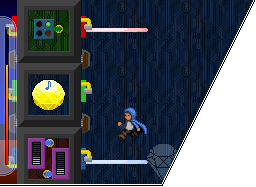Have I mentioned how much I love MMF recently? Ever since I discovered it through its predecessors, I've just taken it completely for granted that I can put sketches of applications together almost instantly without needing to worry about the underlying engine, and it can do a surprising amount in terms of complexity before it begins to get unwieldy. If regular programming languages are a blank canvas with which you can do anything, and most game creation systems are colouring books, MMF just hands you some brushes that might be a tiny bit large for very specific situations. (While ZZT gives you some potatoes.) And in theory, soon you'll also be able to change the export settings and have things immediately in Flash and Xcode (although the instantness of them may be some way off yet). Blame it and the fraction of a gestalt entity known as teogames, then, for this (if it makes you or me feel any better about it). When a discussion about a sliding puzzle on Professor Layton got started, I recalled that I had gone as far as to write a tree-based solver to get past it for me. I then realized that in the solver, I had the perfect tool with which to create my own diabolical challenges and verify they were at least possible, and a competent recreation of the puzzle style was done in just over an hour.  I'm not really sure how I got here I have called this FISP for now. Three of the letters stand for "Impossible Sliding Puzzles". Drag the shapes about with the mouse, with the aim of squeezing the yellow one around to the goal space - the one available level is what I would consider one of the easiest puzzles that I'm going for with this project, and it's solvable in at most 19 moves. The dragging of the shapes is still a bit tuggy if you get caught on other shapes... I'll have to put a bit more effort in to get rid of that. 2010-09-06 14:18:00 3 comments |
 Track the T
Track the T
